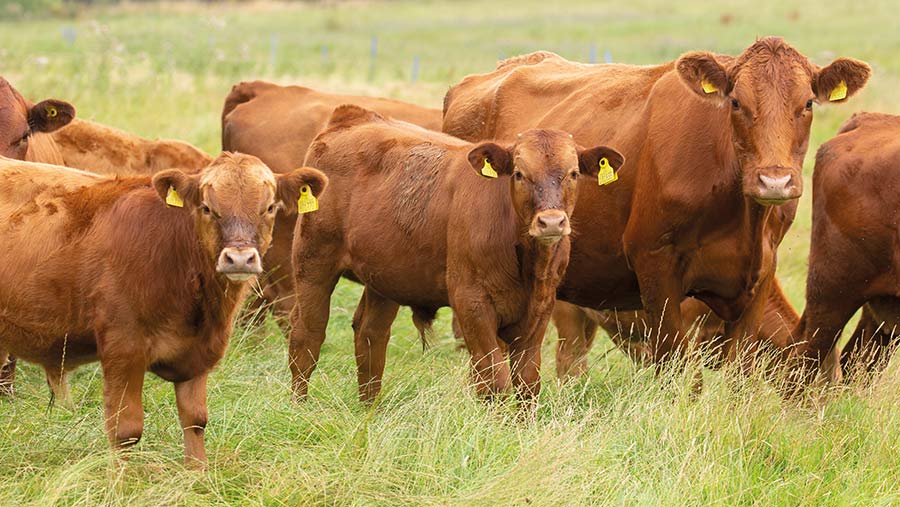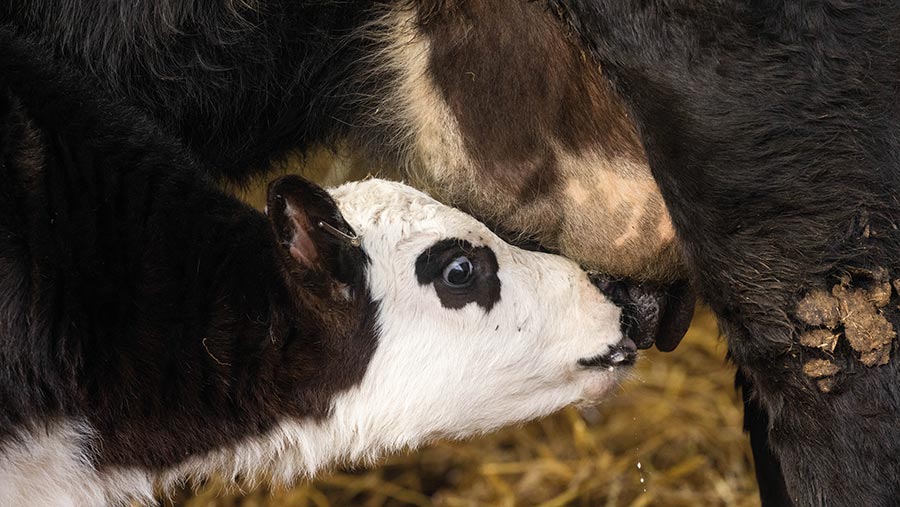Vaccination for beef suckler cow diseases: Why, when and how
 © Tim Scrivener
© Tim Scrivener Are vaccinations a cost-effective insurance policy against devastating disease outbreaks with serious financial consequences? Or are they an unnecessary expense and hassle?
The answer will vary depending on the vaccine and the farm.
But Neil Eastham, of Bishopton Veterinary Group and livestock research company Raft Solutions, believes vaccinations are set to play an even greater role, especially as the industry strives to cut its use of antimicrobials.
“Reducing the incidence of disease and harnessing the additional efficiency that goes with that will also play a huge role in improving sustainability of the beef sector,” he says.
See also: How to manage common suckler calf health challenges
Vaccinations should never be seen as a substitute for good colostrum management, he adds. As the Covid-19 pandemic has shown, no vaccine is 100% effective.
This means good stockmanship, biosecurity, ventilation and testing all remain key to a healthy herd.
Mr Eastham says a good starting point on any beef suckler farm is to consider vaccination against six common diseases:
1. Calf scours
Vaccination can protect young calves from rotavirus, coronavirus and E coli, which are common causes of calf scours.
However, vaccination will only be effective when combined with colostrum of sufficient quality from the dam.
Administered to: Pregnant breeding females
How and when:
Option 1
Single dose, completed three to 12 weeks before calving
Option 2
Primary course is two doses, given four to five weeks apart, for the first year. Annual boosters completed two to three weeks before calving in subsequent years.
2. Clostridial disease
Clostridial disease is most commonly caused by spores in soil and can lead to sudden death in cattle, usually from about six months of age.
However, it can be controlled cost-effectively, says Mr Eastham. “The vaccines are relatively cheap and should form part of the vaccination plan on any suckler farm.”
If there is an outbreak of clostridial disease then the primary course of vaccination can start any time, but typically, dams and youngstock are vaccinated in the following ways:
Option 1 – Vaccinating dams
Administered to: Pregnant breeding females
When: Two to eight weeks before calving
How: Primary course of two doses, four to six weeks apart. This would be followed by an annual booster two to eight weeks before calving.
Option 2 – Vaccinating young animals
It is also possible to vaccinate calves, and this may be necessary if infection pressure or risk is high.
Timings of this vaccination will depend on whether the dam was vaccinated or not, and whether she was boosted appropriately.

© Tim Scrivener
3. Bovine respiratory disease (BRD)
Mr Eastham says that when BRD takes hold on a suckler farm, it costs about £82 a calf. It can be caused by viruses, bacteria, parasites and mycoplasma.
Concurrent exposure to BRD is a major risk factor. Others include stress, handling, transport, poor housing, inadequate ventilation, nutritional deficiency and poor colostrum management.
Growing numbers of farmers are using vaccines against BRD, he says. They can work in two ways – by increasing calves’ immunity and by reducing viral shedding.
Several vaccines are available. “The most appropriate vaccination will depend on a number of factors, not least the bugs circulating, but also the age of the calf and how quickly protection is needed.”
A group approach is important, treating all calves that share the same airspace. Administration ahead of weaning and housing is usually recommended.
4. Infectious bovine rhinotracheitis (IBR)
IBR is a highly contagious disease of the upper respiratory tract, which can develop into pneumonia and cause fertility and milk yield issues.
Once infected, cattle can become carriers and the disease can reactivate during periods of stress. There are many types of IBR vaccine available.
Live vaccines are useful in the face of an outbreak to reduce shedding in newly infected naive animals, while inactivated vaccines can be used to reduce shedding in re-activated latently infected animals.
When: Depends on the individual herd and when it is encountering the virus
Caution: IBR vaccination can have consequences if you intend to export animals, semen or embryos, or send animals to stud.
See also: Only half of farmers store vaccines correctly, survey finds
Vaccination planning
Any vaccination plan should be devised in consultation with the vet and tailored to suit individual systems. It must consider:
• Which diseases to vaccinate against
• Whether the aim is to prevent entry of disease, control disease already present on the farm, or eradicate disease
• Which diseases present greatest risk according to health and performance records
• Which animals will benefit most from vaccination
• When vaccination will provide the most benefit.
A youngstock bleed is a useful way to show the diseases which are in circulation on farm. This requires blood-testing five to six unvaccinated animals aged six to nine months, from each management group.
5. Bovine viral diarrhoea (BVD)
This endemic disease can cause poor fertility, abortion, reduced milk yields, poor calf health and deformities, diarrhoea and immune suppression.
The biggest problem with BVD is when a naive breeding female is infected in the first 120 days of gestation, leading to the birth of a persistently infected (PI) calf.
A PI can appear normal but shed the virus throughout their lives, and will always give birth to another PI.
“The vaccination is safe in pregnancy, but the cornerstone of successful BVD vaccination is vaccinating pre-breeding to give foetal protection,” Mr Eastham says.
Option 1 – Inactivated vaccine – covers Type 1 BVD (the type seen in the UK)
Administered to: Breeding heifers or cows
When: Pre-breeding, completed four weeks before the start of gestation
How: Primary course is two doses, four weeks apart. This should be followed by an initial booster six months later, and an annual booster thereafter.
Option 2 – Live vaccine – covers Type 1 and Type 2 BVD
Administered to: Breeding heifers or cows
When: Pre-breeding, three to four weeks before gestation
How: Primary course is one dose, followed by an annual booster.
6. Leptospirosis
Leptospirosis can cause fertility issues and abortion in cattle. It is also a zoonotic disease, meaning it can be passed to humans.
“Traditionally, most herds vaccinate in spring because it is thought that spring/early summer represents the main season for transmission,” says Mr Eastham.
“But that might not be the case on your farm, so diagnostics will help understand transmission.”
Diagnostics involve blood-testing youngstock (see “Vaccination planning” above) to see if there has been exposure on farm, and assessing the level of risk from factors such as watercourse access, co-grazing with sheep and buying in bulls or other stock.
Administered to: All unvaccinated animals
When: Pre-breeding protection is important, but diagnostics will help inform optimum timing
How: Primary course is two doses, four to six weeks apart. An annual booster is required for all previously vaccinated animals.
Vaccine timing according to the production calendar
Before calving
- Calf scours
- Clostridial disease
Before breeding
- Bovine viral diarrhoea
- Infectious bovine rhinotracheitis
- Leptospirosis
Before weaning/housing
- Bovine respiratory disease
A 14-point vaccination best practice checklist
- Get the first dose right. Mis-timing the primary dose can make all subsequent doses redundant
- Boost at the right time to maintain effectiveness
- Avoid jumping the gun. To get optimal response from young animals, primary doses might need to be delayed until maternally-derived antibodies are lower
- Avoid vaccinating sick animals. Animals in poor health are unlikely to respond effectively to a vaccine
- Be mindful of pregnancy status. Some vaccines cannot be used in pregnancy because of the risk of abortion; other vaccines should only be used in pregnancy
- Consider vaccinating the bull. If you do vaccinate, allow recovery time before breeding. Not all vaccinations are licensed for bulls, but some can be used under a derogation with veterinary advice
- Read the data sheet within the box. It contains recommendations and often answers many questions you may have
- Check if the bottle has to be used the same day or if it can be stored after it has been broached
- Administer vaccinations correctly. Give intramuscular injections in the neck, avoiding the prime cuts where there will be abattoir deductions for injection site lesions
- Use the appropriate length and gauge of needle for the age and body condition score of the animal. Change needles frequently when vaccinating a group of animals
- Ensure guns deliver correctly. Clean guns with warm soapy water on the outside, but hot water only on the inside, and lubricate the gun
- Beware of contamination. If cattle are wet or dirty, it increases the risk of an injection site reaction
- Store vaccines properly, when transporting and on farm. Exposure to heat and sub-freezing temperatures can damage them, making them less effective
- Get a temperature logger for your fridge – they are available online. A Bishopton Farm Vets study in 2020 showed that only 10% of farms stayed within 2-8C in their fridges, which is the appropriate range for most vaccines
Neil Eastham was speaking at an AHDB webinar as part of its #MaternalMatters campaign
